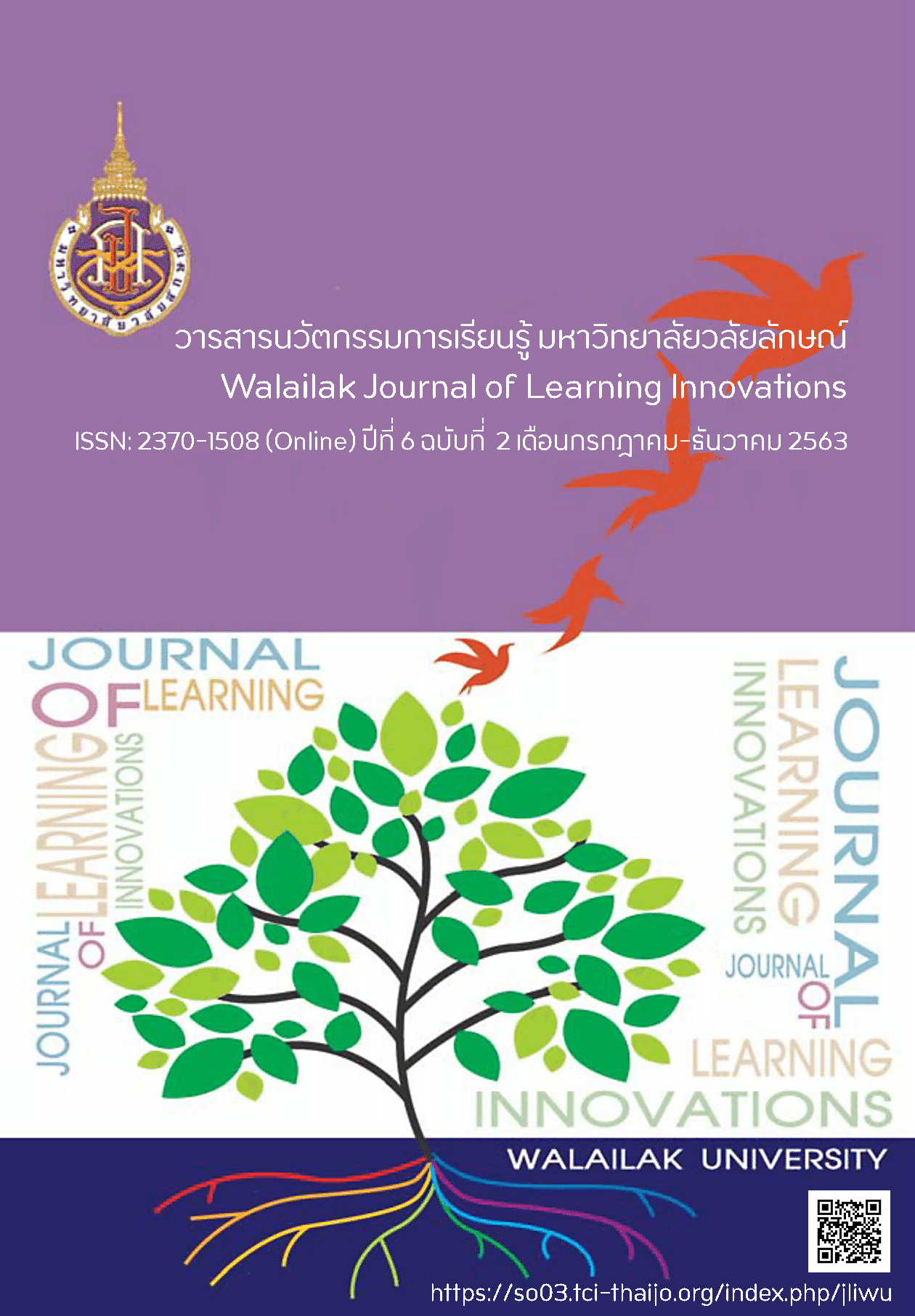International Students’ Perspectives on University Instructional Practices: A Case of a Thai University.
DOI:
https://doi.org/10.14456/jli.2020.8Keywords:
International Students’ Perspectives, Instructional Practices, Thai UniversityAbstract
This survey research aims to: 1) identify the teaching and learning process in the programs taken by international students, 2) explore the expectations and classroom learning experiences of international students studying in the courses at a Thai university and 3) explore the level of satisfaction of international students at a Thai university. The mixed methods approach was used to obtain both quantitative and qualitative data. The population for this study was 107 international students in the Masters of Education in Curriculum and instruction and in Bilingual Education Programs of the research site. By using Krejcie and Morgan, (1970), with the 95% confidence level and 10% errors, 66 returned questionnaires were considered an acceptable sample size. Qualitative data were collected from 12 volunteering interviewees The research was conducted in the first semester of 2019 Academic session. Each questionnaire item was analyzed for the mean score and S.D. Next, the interview contents were analyzed into themes related to the interviewees’ perspectives about instructional practices in the programs. The questionnaire data were analyzed with descriptive statistics: the mean score and standard deviation. The top 3 highest mean scores ranking in order were found. The findings from the questionnaires were: 1) The lecturers used IT to support their teaching (= 4.35, S.D.= 0.77), 2) The lecturers encouraged students to work together in small groups (
= 4.29, S.D.=0.74); and 3) The lecturers mostly used group-work (
= 4.20, S.D.= 0.75) to conduct the activities. As for the qualitative data, the semi-structured interviews revealed four areas: 1) The Lecturer Qualities 2) Engaging Activities and Assignments 3) Supportive Instructional Materials and After-class Consultations and 4) Standard and Good Facilities. The findings pointed out that the teaching and learning process in the programs taken by international students were satisfactory. The lecturers could teach by using the IT facility support and adhere to the student-centred approach by adopting small group work activities. Secondly, the lecturers in the programs were IT literate making classroom activities engaging and using after class consultations to enhance student learning. In addition, in general, students were satisfied with the lecturer quality and supportive facilities.
References
Alber, R. (2015), 5 Highly Effective Teaching Practices, Retrieved from https://edutopia.org. on 26 February 2020.
Best, J. W. (1981). Research in Education (4th ed), New Jersey: Prentice Hall.
Cennamo, K. R. (2010). Technology Integration for Meaningful Classroom Use: A Standards-based Approach. Wadsworth: Cengage Learning.
Chien, Y. G. (2015). International Postgraduate Students in Britain: Reasons for Studying Abroad and issues Related to Adjustment. International Journal of Technology and Inclusive Education (IJTIE), Special Issue, Volume 2, Issue 1, pp. 7254-736.
Ching, Y. C. and Chayanuvat, A. (2019). Factors Influencing International Students’ Decision to Study at Taiwanese Universities. Proceedings of the 3rd Suan Sunantha Graduate School Conference, Vol. 3 (1), pp.1-4.
Civinini, C. (2018, September 14). thepienews.com/analysis/the-lure-of-work-rights-international-students-act-1-policies/. Retrieved from www.thepienews.com: https://thepienews.com.
Creswell, J. W. (2005). Educational Research-Planning, Conducting, and Evaluating Quantitative and Qualitative Research. Pearson Education International: Singapore.
Document indicating Missions of the Ministry of Higher Education, Science, Research and Innovation (MHESI), (2019). Retrieved on 5 April, 2020 from www. mhesi. go.th.
Education in Thailand, Document of Office of the Education Council (OEC), Ministry of Education, Thailand (2004) pp.148-149. Retrieved from http://www.onec.go.th.
Facts and Figures (2017). Document of University of Oxford. Retrieved on 4 April 2020 from http://www. ox.ac.th.
Gomes and Murphy. (2003). An Exploratory Study of Marketing International Education Online. International Journal of Educational Management, Vol. 17(3), 116-25.
Goswami, R. (2018). Popularity of Overseas Education. In The Statesman, 5 April 2018. Retrieved on 5 April 2020 at the statesman.com.
Grierson., J. (2019, September 11). www.theguardian.com/politics/2019/sept/11/uk-work-visas-for-foreign-student. Retrieved from www.theguardian.com: https://
Hartman, R. J., Townsend, M.B. and Jackson, M. (2019). Educators’ Perception of Technology Integration into the Classroom: A Descriptive Study. In Journal of Research in Innovative Teaching and Learning. Vol. 12 (3), pp. 236-249.
Hattie, J. (2012). Visible learning for teachers: maximizing impact on learning, London: Routledge.
Hoge, D. M. (2016). The Relationship between Teachers’ Instructional Practices, Professional Development, and Student Achievement. A Dissertation Submitted in Partial Fulfilment of Requirements for the Degree of Doctor of Education in Environment Administration of the Graduate College of the University of Nebraska.
Holly, K. (2019, June 26). Instructional Practices/Practicum in Education & Training. Retrieved from https;//chs.cleburne.k12.tx.us/apps/pages/index.jsp/uREC_ID=379782&type=u&REC_ID=497899
Krejcie, R.V. and Morgan, D. W. (1970). Determining Sample Size for Research Activities. In Educational and Psychological Measurement, Vol 30 (3), 610-617.
Lichtman, M. (2013). Qualitative Research in Education-A User’s Guide. SAGE Publications, Inc.: Thousand Oaks, California.
Lynch., M. (2015, December 15). www.theedadvocate.org/what-factors-make-a-school-effective/. Retrieved from https://www.theedadvocate.org.
Macsuga-Gage, A.S., Simonsen, B. and Briere, D. E. (2012), Effective Teaching Practices that Promote a Positive Classroom Environment. In Beyond Behaviour. Retreived from journals. sagepub.com. on 9 April 2020.
Mazzarol, T. (1998). Critical Sucess Factors for International Education Marketing. International Journal of Educational Management, Vol.(12), 163-175.
Mazzarol, T. S. (2003). The Third Wave: Future Trends in International Education. International Journal of Educational Management, Vol. 17(3), 90-99.
Rust, V. D. and Kim, S. (2012). The Global Competition in Higher Education. In World Studies in Education, Vol 13 (1), pp. 5-20.
Sokoli, D. and Koren, A. (2017). Qualifications of Lecturers as Indicator of Quality Teaching in Higher Education. Conference Paper of Management, Knowledge and Learning International Conference 2017 organized at Lubin, Poland on 17-19 May 2017, pp. 445-452.
The Bangkok Post, International Education in Thailand—30 Years on. Retrieved on28 January 2020 from http://www.bangkokpost.com.
Xu, A. and Chan, G. (2016). A Study on the Effects of Teachers’ Information Literary and Information Technology Integrated Instruction. In Eurasia Journal of Mathematics, Science and Technology Education, 12 (2), 335-346.
Yilmaz, D.V. (2017). Studying Abroad: Experiences of International Students in a Turkish University. Journal of Higher Education. www.Yuksekogretim.org
Downloads
Published
How to Cite
Issue
Section
License
เนื้อหาและข้อมูลในบทความที่ลงตีพิมพ์ในวารสารนวัตกรรมการเรียนรู้ มหาวิทยาลัยวลัยลักษณ์ ถือเป็นข้อคิดเห็นและความรับผิดชอบของผู้เขียนบทความโดยตรง ซึ่งกองบรรณาธิการวารสาร ไม่จำเป็นต้องเห็นด้วย หรือร่วมรับผิดชอบใดๆ
บทความ ข้อมูล เนื้อหา รูปภาพ ฯลฯ ที่ได้รับการตีพิมพ์ในวารสารนวัตกรรมการเรียนรู้ มหาวิทยาลัยวลัยลักษณ์ ถือเป็นลิขสิทธิ์ของวารสารนวัตกรรมการเรียนรุ้ มหาวิทยาลัยวลัยลักษณ์ หากบุคคลหรือหน่วยงานใดต้องการนำทั้งหมดหรือส่วนหนึ่งส่วนใดไปเผยแพร่ต่อเพื่อกระทำการใดๆ จ้อต้องได้รับอนุญาตเป็นลายลักษณ์อักษรจากวารสารนวัตกรรมการเรียนรู้ มหาวิทยาลัยวลัยลักษณ์ก่อนเท่านั้น


